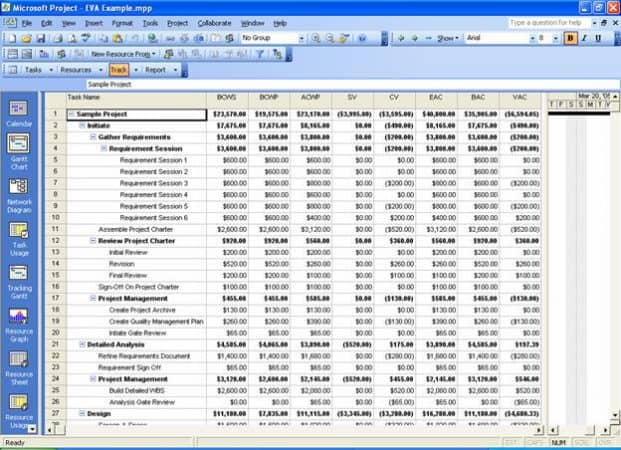
To apply earned value to your Microsoft Project plan, you will need to complete the following six tasks:
- Enter Resources with hourly bill rates in the Resource Sheet view
- Assign resources to tasks in the Gantt Entry view
- Save the Project Baseline
- Record Actual Start/Finish and Actual Work each week in the project plan
- Review EVA metrics using the Earned Value views and reports
- Calculate Schedule Performance and Cost Performance indices
Step 1. Enter Resources in the Resource Sheet View
The resource sheet view allows project managers to define the different resources available to a project. MS-Project tracks work resources and material resources. Work resources are the people and equipment that consume time to accomplish project tasks. Material resources are the consumable supplies, such as steel, concrete, and other construction materials used to complete the project tasks. Most software projects are based on work resources with different cost rates. Figure 1 depicts all the team members assigned to a project with their hourly cost rates.
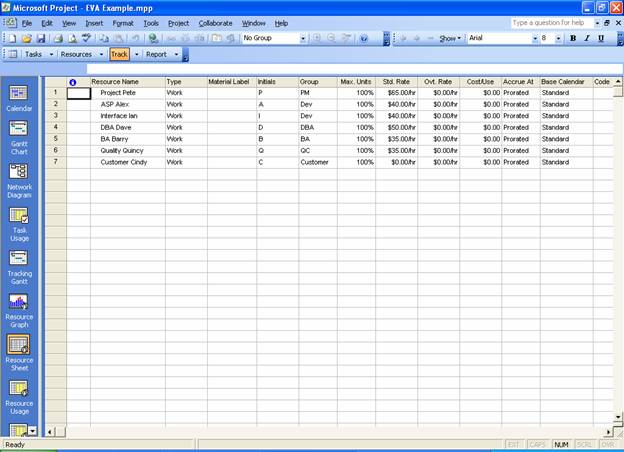
The resource costs must be entered to calculate the project’s planned value (PV) or budgeted cost of work scheduled (BCWS). Customer Cindy was assigned a $0.00 amount in this example since the client wasn’t charged for participating in the project. If you are managing an internal IT project and tracking costs for IT and functional resources, assign a standard rate as appropriate.
Step 2. Assign Resources to Tasks
After establishing your pool of resources and their costs, the next step is to assign resources to all your tasks in the Gantt Entry view. There are several ways to assign resources in MS-Project, but the most direct method is to click on the Assign Resource Icon in the Resource Management Tool bar and assign the appropriate people to the task. Figure 2 identifies the Assign Resource Icon and the Assign Resources dialog box.
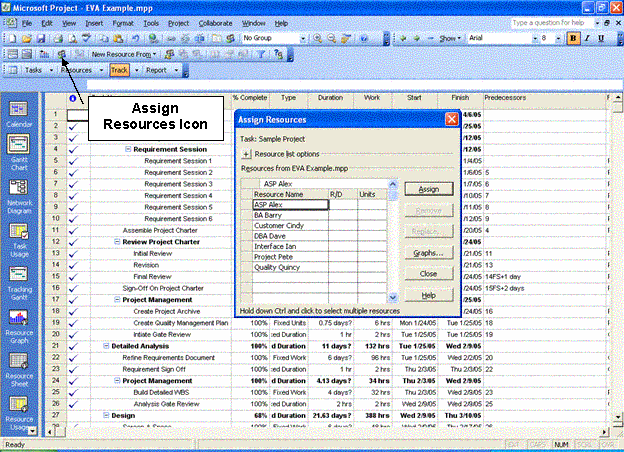
Suppose you are applying earned value to an existing plan. In that case, the resources should already be assigned, and the costs for each task are automatically calculated when the standard rate is assigned. After the resources have been assigned, MS-Project calculates the task’s cost. To view the current costs, follow these steps to use the combination Task Entry and Task Usage view.
- Click on the Task Entry View icon in the Resource Management toolbar or click on the Gantt Chart view and select Split from the Window menu
- Click anywhere on the lower window pane to activate it
- Select the Task Usage view in the lower window page
- Select View – Table and select the Cost table.
- Click on any task in the upper window to view the cost information.
- Figure 3 depicts the project’s total cost using Task Entry and Task Usage view.
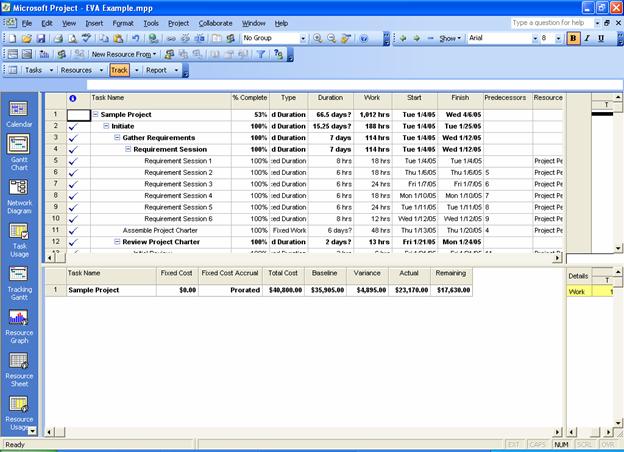
Try selecting various tasks to view the total cost. In the EVA Example.mpp template, click on the “Code Screen A” task. The cost of developing the code for one screen is $3200 since the developer, ASP Alex, bills $40.00 per hour for 80 hours of work. Understanding the actual cost to deliver a task provides a better awareness of major project deliverables and their complexity. It allows the project manager to manage each task as a budget item in their portfolio instead of just a list of tasks.
Managing the costs at the task level helps improve productivity by planning for quality team meetings. In the EVA Example, if all team members meet every week for 1 hour, the project will cost $530.
If you were meeting with a consultant who charges $500 per hour, wouldn’t you want to organize and prepare for this meeting adequately? Understanding the costs of operating and managing the project will help avoid costly meetings and motivate the project manager to plan for productive and effective meetings.
Once you’ve reviewed the total project costs, verify the total amount does not exceed your budget. Project budgets are often estimated at a high level without the benefit of a detailed bottom-up estimate. If the project’s cost exceeds the original budget, a funding supplement or scope change may be required.
Step 3. Save the Project Baseline
After you’ve built your plan, assigned resources, and confirmed the budgeted costs, the next step is to baseline the project plan. Saving the project baseline is critical in measuring and managing your project’s performance. To save the project baseline, follow these steps:
- Select Tools – Tracking – Save Baseline
- The Save Baseline Dialog box appears, and select the Save Baseline radio button
- Select the Entire Project radio button to baseline the entire project plan, or select the Selected Tasks radio button to baseline any chosen tasks.
- Click OK
The Baseline Start, Baseline Finish, Baseline Work, Baseline Cost, and Earned Value fields will be populated. Suppose your project is in process, and you haven’t established a baseline. In that case, you’ll need to baseline any future tasks and manually edit the baseline data for completed and in-process tasks. Saving the project baseline before project execution avoids these manual-editing procedures.
Step 4. Record Project Actuals
Once the baseline is established and the team begins working on the plan, tracking the actual costs and start and finish dates will help calculate the project’s earned value. Tracking the Actual Start and Actual Finish dates and comparing them to the Baseline Start and Baseline Finish dates will determine any schedule variances. Tracking the Actual Work and comparing it to the Baseline Work will be used to determine any cost variances. After you’ve entered your project’s actual dates and hours for the week, you can view the earned value information.
Step 5. Review the EVA view and reports
It may seem like reaching this point took a lot of effort, but if you’ve established your project baseline and are tracking project actuals, the earned value information is just a few mouse clicks away. MS-Project uses the Earned Value, Earned Value Cost Indicators, and Earned Value Schedule Indicators tables to display earned value information.
To view the Earned Value table:
- Select the window pane to display the earned value information if you use a combination view.
- Select View – Table – More Tables menu item.
- The More Tables dialog box will appear, and you can select from various tables.
- Select the Earned Value table and Click OK.
- The current earned value information will be displayed for each task.
Figure 4 displays the Earned Value table for each task in the project plan.
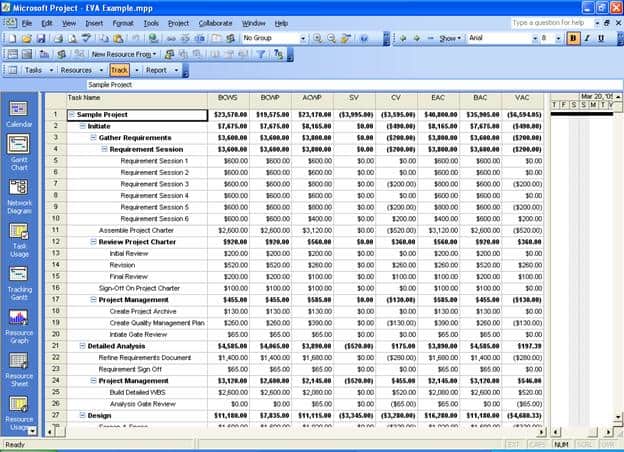
The Earned Value table contains eight earned value fields to represent the project’s earned value
Field Name
BCWS
BCWP
ACWP
SV
CV
EAC
BAC
VAC
Field Description
BCWS
BCWP
ACWP
SV
CV
EAC
BAC
VAC
The Earned Value data is calculated based on the current date. As of 3/4/2005, the project had planned to complete $23,570 dollar of the planned budget. This is the budgeted cost of work scheduled or the planned value for the project. The project completed $19,575 dollars of the project budget. This is known as the earned value or budgeted cost of work produced. Finally, it cost the project $23,170. This is known as the actual cost of work produced or actual cost.
You had planned to complete 65 percent of the project in percent complete terms. However, you only completed 54 percent of the project and spent approximately 65 percent of the budget. The percentages are calculated by dividing the respective BCWS, BCWP, and ACWP by the original project budget or BAC (Budget At Complete).
By examining the SV (Schedule Variance) and CV (Cost Variance) columns, you can quickly determine if the project is on schedule regarding project plan performance and budget. If the SV and CV columns are zero, then the project is on track and on budget. Schedule and cost variances need to be monitored throughout the project to keep it under control.
The EAC column provides an estimated cost after the project. If the project continues to perform with these cost and schedule variances, the actual cost of the project will be $40,800. Remember the original project budget was $35,905, and the total project cost variance will be $6,594. Your customer and a contingency budget may be able to fund the cost overrun. Still, the VAC (variance at completion) should be reviewed with your customer to manage the budget and scope accordingly.
The Earned Value report in MS-Project will also display the earned value for each task in the plan. To run the report:
- Select View – Reports
- Click on the Costs icon and click Select
- Click on the Earned Value report and click Select.
The earned value report and table provide the objective metrics to assess the project’s health. Reviewing the SV column lets you quickly identify the tasks running behind schedule. The next step is to calculate your status report’s schedule and cost performance indices.
Step 6. Calculate Schedule Performance and Cost Performance indices
The schedule performance index (SPI) measures the project’s actual progress relative to the baseline schedule. The cost performance index (CPI) measures the project’s earned value compared to the costs incurred. The indices are calculated using the following equations:
SPI = EV / PV
CPI = EV / AC
In our project example, the SPI is $19,575 / $23,570 or .83, and the cost performance index is
$19,575 / $23,170 or .84. Both calculations are less than 1 and indicate the project is behind schedule and over budget. The project manager needs to address these variances to improve the project’s performance. During a project execution, a project can often run behind schedule or over budget for a given period. The schedule and cost performance indices help summarize the project’s objective performance and should be included in the project’s status report.
Earned Value Management in 6 easy steps
In six easy steps, you can calculate your project’s earned value. The actual earned value calculations only require a few clicks of the mouse, but the excellent project management processes of tracking actual performance against the project baseline require discipline. Project managers need to measure performance to manage their projects successfully and consistently. Implementing earned value reinforces the need to execute against a baseline project plan and track variances.
MS-Project’s earned value calculations are based on the status date in the Project Information dialog box and are compared against the project baseline. MS-Project uses the current system date in the EVA calculations if a status date is not set. If the plan wasn’t updated for three weeks and the project manager viewed the earned value information, the calculations would be further off since three weeks have past since the last review. Remember, earned value is a point-in-time evaluation of the project. Incorporating these objective metrics in your status report will help guide the project discussion around schedule, budget, and the subjective project status narrative.
Additional Earned Value Management Resources
- Earned Value Project Management by Quentin Fleming
- Earned Value Management 3rd Edition by Quentin Fleming
- Practice Standard for Earned Value Management by Project Management Institute
Recommended articles: The Pros and Cons of Using MS Project Software | Microsoft Project Pricing Plans & Costs Guide
Andrew Makar, DMIT, PMP, CSM is an IT director with delivery experience across projects, programs and portfolios in Digital Marketing, Automotive, Software and Financial Management industries. He is an enthusiastic leader who effectively translates project management theory into practical application. His area of interest and practice is in implementing Agile processes and SCRUM techniques to deliver better software to his customers. Find out more about Andrew on andymakar.com and please reach out and connect with Andrew on LinkedIn.